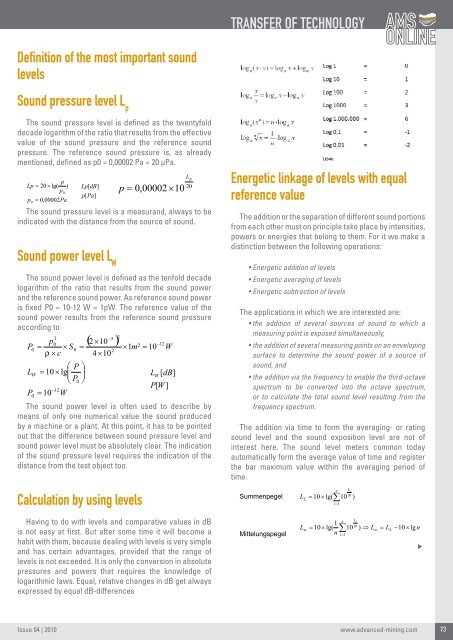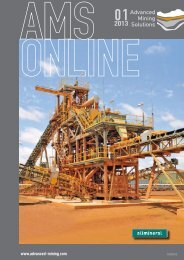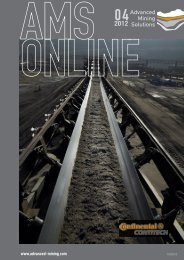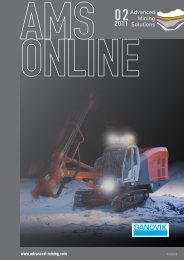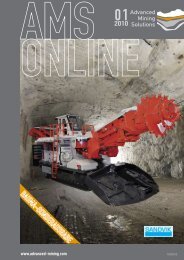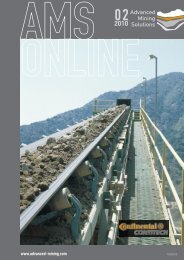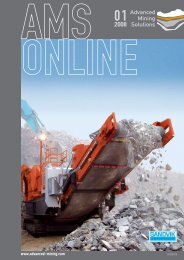A new face drilling rig for narrow tunnels and ... - Advanced Mining
A new face drilling rig for narrow tunnels and ... - Advanced Mining
A new face drilling rig for narrow tunnels and ... - Advanced Mining
Create successful ePaper yourself
Turn your PDF publications into a flip-book with our unique Google optimized e-Paper software.
Definition of the most important sound<br />
levels<br />
Sound pressure level L p<br />
The sound pressure level is defined as the twentyfold<br />
decade logarithm of the ratio that results from the effective<br />
value of the sound pressure <strong>and</strong> the reference sound<br />
pressure. The reference sound pressure is, as already<br />
mentioned, defined as p0 = 0,00002 Pa = 20 μPa.<br />
Lp = 20×<br />
lg(<br />
p = 0,<br />
00002Pa<br />
0<br />
Issue 04 | 2010<br />
p<br />
p<br />
0<br />
)<br />
Lp[<br />
dB]<br />
p[<br />
Pa]<br />
p = 0,<br />
00002 × 10<br />
The sound pressure level is a measur<strong>and</strong>, always to be<br />
indicated with the distance from the source of sound.<br />
Sound power level L W<br />
The sound power level is defined as the tenfold decade<br />
logarithm of the ratio that results from the sound power<br />
<strong>and</strong> the reference sound power. As reference sound power<br />
is fixed P0 = 10-12 W = 1pW. The reference value of the<br />
sound power results from the reference sound pressure<br />
according to<br />
2<br />
p0<br />
P0<br />
= × S0<br />
=<br />
ρ × c<br />
L W<br />
P<br />
0<br />
⎛<br />
= 10×<br />
lg<br />
⎜<br />
⎝<br />
= 10<br />
−12<br />
W<br />
P<br />
P<br />
0<br />
⎞<br />
⎟<br />
⎠<br />
−5<br />
2<br />
( 2× 10 ) −12<br />
× 1m²<br />
= 10 W<br />
4×<br />
10<br />
2<br />
L W<br />
[ dB]<br />
P[<br />
W ]<br />
The sound power level is often used to describe by<br />
means of only one numerical value the sound produced<br />
by a machine or a plant. At this point, it has to be pointed<br />
out that the difference between sound pressure level <strong>and</strong><br />
sound power level must be absolutely clear. The indication<br />
of the sound pressure level requires the indication of the<br />
distance from the test object too.<br />
Calculation by using levels<br />
Having to do with levels <strong>and</strong> comparative values in dB<br />
is not easy at first. But after some time it will become a<br />
habit with them, because dealing with levels is very simple<br />
<strong>and</strong> has certain advantages, provided that the range of<br />
levels is not exceeded. It is only the conversion in absolute<br />
pressures <strong>and</strong> powers that requires the knowledge of<br />
logarithmic laws. Equal, relative changes in dB get always<br />
expressed by equal dB-differences<br />
Lp<br />
20<br />
TRANSFER OF TECHNOLOGY<br />
Energetic linkage of levels with equal<br />
reference value<br />
The addition or the separation of different sound portions<br />
from each other must on principle take place by intensities,<br />
powers or energies that belong to them. For it we make a<br />
distinction between the following operations:<br />
• Energetic addition of levels<br />
• Energetic averaging of levels<br />
• Energetic subtraction of levels<br />
The applications in which we are interested are:<br />
• the addition of several sources of sound to which a<br />
measuring point is exposed simultaneously,<br />
• the addition of several measuring points on an enveloping<br />
sur<strong>face</strong> to determine the sound power of a source of<br />
sound, <strong>and</strong><br />
• the addition via the frequency to enable the third-octave<br />
spectrum to be converted into the octave spectrum,<br />
or to calculate the total sound level resulting from the<br />
frequency spectrum.<br />
The addition via time to <strong>for</strong>m the averaging- or rating<br />
sound level <strong>and</strong> the sound exposition level are not of<br />
interest here. The sound level meters common today<br />
automatically <strong>for</strong>m the average value of time <strong>and</strong> register<br />
the bar maximum value within the averaging period of<br />
time.<br />
n<br />
∑<br />
i=<br />
1<br />
10<br />
Summenpegel L = 10×<br />
lg( 10 )<br />
Mittelungspegel<br />
Σ<br />
n Li<br />
1<br />
Lm = 10×<br />
lg( ∑<br />
m Σ<br />
n i=<br />
1<br />
L i<br />
10 10 ) ⇒ L = L −10×<br />
lg n<br />
www.advanced-mining.com<br />
73


